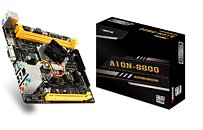Wednesday, January 23rd 2019

BIOSTAR Introduces Edge Computing Solution with SoC Motherboard -A10N-8800E
BIOSTAR, a leading manufacturer of motherboards, graphics cards, and storage devices, introduces a solution for edge computing, the BIOSTAR A10N-8800E system-on-chip (SoC) mini-ITX motherboard, for faster data access and computing over traditional cloud solutions. The BIOSTAR A10N-8800E integrates the AMD FX-8800P processor, typically found in AMD mobile computing, for superb processing performance and power efficiency. Even with a mini-ITX form factor, it includes features such as dual channel DDR 4 2133 support, USB3.1 Gen. 1, PCI-e M.2 16Gb/s and HDMI output. The BIOSTAR A10N-8800E is an excellent motherboard for edge computing applications for home, office or online gaming.AMD A10N-8800E SoC Motherboard with Essential Features
The BIOSTAR A10N-8800E integrates the AMD FX-8800P processor with heatsink and the AMD Radeon R7 graphics onto the mini-ITX motherboard to take full advantage of mobile performance and power efficient technology.
SoC with AMD Carrizo chipset
The BIOSTAR A10N-8800E integrates the AMD FX-8800P processor with heatsink and the AMD Radeon R7 graphics onto the mini-ITX motherboard to take full advantage of mobile performance and power efficient technology.
SoC with AMD Carrizo chipset
- AMD FX-8800P quad-core processor running up to 3.4GHz
- AMD Radeon R7 graphics for superb on board graphics
- USB 3.1 Gen 1 transfers data up to 5Gbps for faster transfer speeds.
- SATA 3 6Gb/s provides a higher bandwidth to retrieve and transfer HD media. With this super speed data transfer, SATA 3 allows an incredible data boost which is 2x faster.
- PCI-e M.2 16Gb/s is the latest storage interface, it delivers higher bandwidth and lower latency. It is 1.6 times faster compared with PCI-e M.2 10Gb/s.
- Realtek ALC887 7.1-Channel HD Audio ensures high-definition audio with minimal loss of audio fidelity.
- 4K2K resolution enables 4X better high-definition image display. The resolution of full HD 4K2K display is highly detailed content that fills the entire screen with life like images.
- DirectX 12 takes our gaming to the next level by maximizing the graphics potential of your computer.
- Integrated HDMI to output HD resolution graphics
- Protection+: Super Anti-Surge Protection, ESD Protection, OV/OT Protection
- Exclusive Anti-Surge protection provides better protection and extends product life.
- ESD to protect the motherboard from electrical overstress
- Full protective features against current overvoltage, overload and over temperature.
- Super LAN Surge Protection
- Provides 4X more advanced antistatic protection capabilities than the competition by adding an integrated chip to strengthen electrical stability and prevent damage from lightning strikes and electrical surges.
- Header Zone allows users to easily set up or upgrade components.
- Diver UI for self-intuitive graphic interface to set up drivers
- UEFI BIOS to go through BIOS setting quickly
- The BIOSTAR A10N-8800E rear I/O ports include: 1 x PS/2 Mouse, 1 x PS/2 keyboard, 2 x USB 3.1 Gen1 ports, 2 x USB2.0, 1 x HDMI, 1 x VGA, 1 x LAN port, and 3 x Audio connectors.


8 Comments on BIOSTAR Introduces Edge Computing Solution with SoC Motherboard -A10N-8800E
BIOSTAR probably got a batch of those for really cheap.
There are, however, few things I don't like about this product:
1) HSF is too small. It's a bad sign that these chips are also capped at 15W TDP and will suffer from the same "hiccups" as HP laptops, including media acceleration and raw CPU perf
2) They went ahead with DDR4 instead of DDR3, which will only increase the overall cost of your HTPC system
3) No WiFi, and no WiFi slot
4) Only 2 SATA, and that PCIe is wired to x1, which can only accommodate cheap crappy 2-port SATA expansion cards. Can't install a decent RAID controller (e.g. it's also bad choice for NAS).
5) SoC only supports HDMI 1.4, which also makes it a bad modern HTPC (max output is 4K@24Hz, and if it's as bad as it was on laptops - might as well run it at 1080p)
6) Only one shitty RTL8111 NIC, adding "bad edge router" to the bad list.
So, it's not NAS board, it's not HTPC board, not router board and the only remaining use for it is badly planned miniature office PCs or overpriced thin clients.
I love BIOSTAR, but sometimes they make very funny design choices.
2) Yup, although DDR3 is getting up there in price. Unless you get a good deal from a private individual. I personally wouldn't buy a new system that relied on DDR3. If you want DDR3, buy a good used system (Sandy-Bridge, Ivy-Bridge, Haswell are all capable and cheap). If you get something new (for warranty etc.) go with DDR4.
4) Is that PCIe slot wired for x1? The website says x16 and the previous versions of the A68N were either x4 (Kabini) or x8 (Carrizo), so Biostar has been good about not lying in their spec sheet. The M.2 slots takes 4 lanes, but that would still leave the possibility of an x4 slot (I don't have the block diagram on hand).
5) They really should have used displayport as well, which is supported natively. HDMI 1.4 sucks in 2019.
Overall, this is a bit of an odd one. Unless the 25W TDP of something like the Biostar A686N-5745 with an A10-5745 allows it to stretch its legs a bit more, this is more powerful (2.9 GHz vs 3.4 GHz, 384 VLIW Shaders @ 626 MHz vs 512 GCN Shaders @ 800 MHz, 32nm vs 28nm, only the L2 Cache is in Carrizos favour, 4MB vs 2MB). But still nowhere near powerful enough that I would consider it, since it is a dead end system.
Your A68N had a PCIe x4 routed to x16 slot, so at least you could get a RAID card, dual/quad NIC or a decent LP GPU running without issues or bottlenecks.